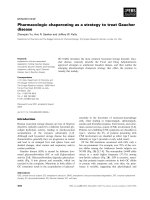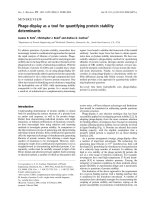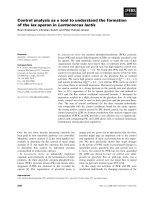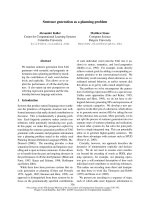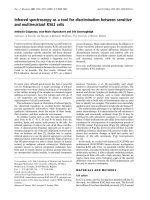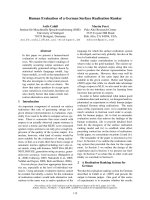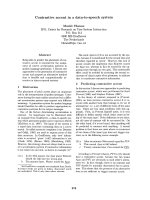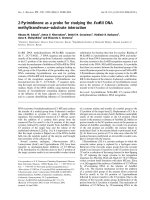Báo cáo khoa học: "TAG''''s as a Grammatical Formalism for Ceneration" doc
Bạn đang xem bản rút gọn của tài liệu. Xem và tải ngay bản đầy đủ của tài liệu tại đây (757.77 KB, 10 trang )
TAG's as a Grammatical
Formalism for
Ceneration
David D. McDonald and
James
D. Pus~ejovsky
Departmmt of Compute~ and Information Scienc~
Un/vemty of Mam,dzm~tm at Amherst
I. ~mnct
Tree Adj~g Grammars, or "TAG's', (Josh/, Levy &
Takahash/
1975;
Josh/ 1983; Kroch & Josh/ 1965) we~
developed as an al~ma~ive
to
the aandard tyntac~
formalisms that are
,,_~'~ in theoretical ~,.ll,/~s of languaSe.
They are a.rwac~ve because they may pin,vide just the
asFects of context seusit~ve exptes~e Fmv~r that actually
appear in human lanSuages while otherwise
r~alning
context free.
"['n/s paper ___~,~,ibcs how we have applied the theory of
Tree Adjoining Grammars to natural language generation.
We have ~ attracted
to
TAG's because their cemral
opemtiou ~he exteamou of an
"initial" phra~ m~ca~u tree
through the incl~/ou, at re,? ,~y came~/aed
loeatinus, of oae or
mmu "au~!!iar~'* ~ds
dixec~ to cextain ceat~ ol~rat~m of our owu,
p~rfonnnce-one~ted theory.
We besm by briefly _,~,,-,ibin 8 TAG's
u
•
formalism
for phrase ram:rare in
a com~___~ theory,
and summar/ze
the points in the theory
of
TAG's that are germainu
to our
own theory. We them conmdm' generaUy the poation of
a
grammar within the geueratiem process, inemducmg our use
of TAG's through a contrast with how oth~nJ have used
system~ grammars. This takes us to the ,~,~,~
resulm of
our psper:, usng eaamp/es from our research with
wefl.wrR1eu trots from
aewupapmm, we walk throush our
TAG insp/~ed treatments
cl
r~ng and wh-movemem, and
show
the cc~denc~ of the
TAG ~adjunct/oo" oper~t/oa
and our "attachment" process.
In the final tectiou we discuss ~mau/ons to the
theory,
motivated by the way we usa the operafiou cmveqxmdin 8
to TAG's" adjun~iou
in
performance. This
mssesss that the
compe~eace theory of TAG's can be profitably projoc~ed
to
s~na:tur~ at the morphoiogicaJ
leve/ as
weft as the preseat
syntacuc level
2.
Tree Ad]unctioo Grammars
The theoretic~ apparatus of a TAG cons/sin of a
primitive~ defined set of "elememary" phrase smgnu~
gge~ a Jqinkins'~ l'~lgJOgl thag ~ ~ ~ to
de~e
dependency relations between two nodes within an
elemeutary tree, and an "adjunction" operarlon that
combines trees under specifiable constraints. The elementary
frees are divided
into gwo sets: initLll
and auxiliary. Initial
wea have only terminals at their leaves. A~///m.y
we~ are
distinguished by having role
non-terminal among their
leaves; the category of th/s node must be the same u the
,~tegol~
of the root. AU c/~l ~1 ~ ~
"~nnlnlmaJ n ill
the serum that they do am regunm on any
nou-~rminal.
A mxle NI in an elementa,lry tree may be linked
(co-indaad) to a second aode N2 in the same tree
provided NI c-commands N2. ~Jnklng is used to indicate
grammadcaUy defined del~de~:/es between nodes ~.b u
subcatesorizatiou relatioashipe or fdler-sap dependencies.
Links are p~ved (thouSh "m~.bed out") when their txee
is extended throu~ adjunctioo; this is the mechan/sm
TAG's use to re~re~___ t unbounded del~denczes.
Seatea©u der/va0om start with an in/tial uee, and
contimm via the adjunctim of an arbitrary number of
auxiJumj trees. To adjoin an auxiliary tree A with reo¢
,-~tegory X to a in/t/a/ (or clenv~) tree T, we first se/ecz
some node of catesory X within T to be the point at
which the adjunction is to occur. Then (1) the subcree of
T dominated by that instance of X (carl it X') is removed
from T, (2) the au.vili~ry ~ A is kn/t into T at the
pos/tioQ where X" had beret Icelted, and (3) die sublree
detainer_ 4 by X" is kn/t into
A
to replace the second
cgcurencu of the catego~ X at T's frontier. The two trees
have now been merged by "up/icing" A into T, disp/acing
the subcrea of T
at
the
pmnt
of the
adjunction to
the
fromier of A.
For ~-ram~e we cmdd take the initial tree:
~. who~ doa ~ Zohn ~ke
"i
] l
(the subucnlX "i" indJ~ttes that the "who" and the trace "e"
am Unked) and adjoin to it the aux/Uar/ Uree:
to pTedum the derived trea:
94
Adjunctioe may be "constrained'. The grammar writer
may specify which specific trees may be adjoined to a given
node in an elementary tree; if no specification is given the
default is that there is no constraint and that any auxiliary
tree may be adjoined to the node.
2.1
Key f,_,_m~ of the theory of TAG's
A TAG tqxectfi~ mrfaee m'ucture. There is no notion
of derivation from deep structure in the theory of
TAG's the primitive trees are not transformed or otherwise
changed once they are introduced into a text, only
combined with other primitive trees. As Kmch and Jmhi
point out, this means that a TAG is incomplete ms an
account of the structure of a natural language, e.g. a TAG
grammar
wW
contain ~th an
active
and
a passive
form of
the same verbal sutx:ategurization pattern, without an
theory-mediated description of
the
very
clme
relationship
between them.
To our minds this is by uo means a deficit. The
p~c~lural machinery that generative grammars have
traditionally carried with them to characterize relations like
that of active to passive has only gotten in the way of
employing tho~ characterizations in processing models of
generation. This is
because
a generation model, like any
theory of performance, has a procedural m'ucture of its
own and cannot coexist with an incompatible one, at least
not while
still operating
efficiently or
while
retainin 5
a
simple mapping from its
actual
machine to the virtual
machine
that
its
authors put forward ms their ao~unt of
psycholinguistic data.
Our own generator uses surface structure ms its only
expficifly represented linguistic level. Thus grammatical
formalisms
that
dwell
on
the rules
governing surface form
are
more useful to us than those that hide those rules in a
deep to surface transformational process.
A TAG Involves the manlpulatlea of very mmail
demantary m'uctures.
This
is _'~'__~_use
of
the
stipulation
that elementary trees may not include recumve nodes. It
implies that the sentences one ~ in everyday usage, e.g.
aewpaper texts, are the result of many _o_,__e~6_ 're adjunctions.
This melds nicely with a move that we have made in
recent years to view the conceptual representation from
which generation proceeds ms
consisting
of a heap of very
small, redundantly related information units that have been
defiberately selected by
a
text plannin~g ~ from the
total state of the knowledge base at the time of utterance;
each such
unit
will correspond in the final te~
to
a
head
lexical item plus selected thematic arguments a linguistic
entity that is easily projected onto
the elementary trees of
a
TAG.
TAG U~n7 Indudes ~ly ow operm~oa, mqemetlom,
and otherwim ~-, u .4,.,,.~ to the elemantary trees
that go tnts•
text. This
compom well with the indefibllity
mpulatiou in our mode/ of gene~uion, tince adected text
fragments ~ be ~
di~y all ~ by th@ gl~mm~r
without
the
need for any later transformation. The
composition options delimited by the constraints on
adjunction given with a TAG define a space of alternative
text forms which can correspond directly in generation to
alternative conceptual relations among information units,
alternatives in rhetorical intent, and alternatives in t,,~me
style.
3. Adapting TAG's to Generation
The mapping from TAG's as a formaligm for
competence theories of language to our formalism for
generation is strikingly direct. As we described in Section 5
their adjunction operation corresponds to our attachment
Wcgess; their constraints ou adjunction correspond to our
attachment points; their surface structure trees correspoad to
our surface structure trees, t We further hypothesize that
two quite strong correspondence claims can be made,
though
considerably
more
experimentation and theorizing
will have to be done with both formalisms before these
claims can be c~nfirmed.
I. The primitive information units in renlization
specifications can be realized exclusively ms one or
another
elementary tree ms def'med by a suitable
TAG, i.e. linguistic criteria can be used in
derermmmg the proper modularity of the
conceptual structure. 2
2. Convex~ly, for any textual relationship which our
generator would derive by the attachment of
multiple information units into a
~ingle
package,
there is a correslxmding rule of adjunct/on. Since
we u~ attachment in the rp,~li,~tiou of nominal
compounds like
"o//
tanker',
this has the force of
extending the domain of TAG analyses into
morphology. (See section 7).
4. 1"he Place of Grammar in a Tneory of
Generat/on
To understand why we are looking at TAG's rather
than some other formaJi~n, one must first understand the
role of grammar within our ~g model. The foflowing
is a brief summary of the model; a more complete
description can be found in McDonald & Pustejovsky
] Our model ot geaeratioe dora cot eml:~oy the ~ tre~ ot
labe.t~ ~ that appear in most ttmm, etical ~ ~ Our
mtrfa~ strtEtut~ iaeoqlofat~ tim m~umti~ ~ ot tzem, but it
also iacl ,.,t.'- reifi~tiom ot coeMitt~at pomtio like "mbject" or
"z~ ' " and is b~t~ ~ overall , an "czemnab t-
teq;~:am o( labeled pemtiom'. We dimm this furth~ in t~" ._ 5.1.
2 If this hylm~ m race.tel, it has very mmalemttat
im~icatiom for tha "sire" of the iaforma~oa umm that th6 tat
woukl not be realized u u~m that inc/uda recun/ve nodes. We will
diEum ,t,i. and o 's implJ~tiom in
• ta-~" psp~'.
95
We have always had two complementa~ goats in our
research: on the one hand our generation program hu had
to be of practical utility to the Imowedge based expert
systems that use it as part of a natural language interface.
This
means
that architecturally our generator
has always
dmgned to produce text from mecepmal
spm:~catlons, "plans", devdo~ by another program and
comequenfly
has had
to be mmtive to the limitations and
v-ap~g approaches of the present state of the art in
concepmal reprewntation.
At the same time, we want the architecture of the
vimud m~hlne that we abstract out of our program to be
effective as a murce of psycholinguis~c hypothesm about
the actual generation
p~c~em
that humans use; it should,
for example, provide the basis for predictive ___~mts of
human speech error behavior and apparent p~annin s
limitatioB. To achieve this, we have restricted om~lves to
a highly constrained set of representations and operations,
•nd have adopced strong and mgge~ve stipulations on our
dmigu such as high locality, information encaptmlation,
online qua~-realtimo rtlotime performan~, and inclelibility. 3
restricts us u ptogrammm, but disaplines us as
theomu.
We me the pmce~ of generation u involving tluen
temporally intmmingied activities: (1) determinin$ what goats
the u~(~ is tO ac.hie~e, (2) plxnnin S what informaboll
omtent and rhetorical force will best meet those goals given
the context, and (3) realizing the tpectfied inlormation and
rhetorical intent as a grammatical teat. Our l/agum~
camom,~ (henceforth
LC), the Zetalisp ~ MUMBLE,
handles the ~
of these activities, tskin]g a "TMal~tiO~
qx~ificatim ~ as input, and producing a mmm of
morpUotosicaay s~,-~,;.,.a wor~ u output.
As described in [McDonald 19@t],
LC is
a
"~on~ed" process: it ~ the m-~nue of the
realization specification it is given, plus the syntactic surfa~
ttrueture of the text in progrem (which it extends
incrementally as the qxa:£fication is mafized) to directly
control its sctions, int~t,~hag them as though they were
sequential computer programs. This technique imposes
strmtg demands on the clem~ptive f~ used for
3 "Indett, iaty" in a compmattoa requm= that m a~oe o4 •
pro=m (matml dmmm. cee~-mml repmmmatiom. ~ ~m.
ctg.) call be ~ tmdom olgg it has beta pegtonm& Maw/
mmbacMrackiag, mra~l pml~lm dem~ ha~ tim property; it is
our tam
for wdmt ~
[Lel~ I rdermd to m tim Ixepany o( tXmlg
4 A realbams ~dfka~oa m Jar, rurally be ,-~-~ m
m w~ tmmy r~sndm~, ~ ~ t~t ~ -" tim
"me~aSo le~:l" ~~ ~
• tat.
5 Whigh m m my that it pemmtly ~ meitt~8 mtha
~m tats. We expect m m~t mtb ~ ompm ~,
~, 8nd tl~ amd to ,,Wm~ tl~ mpt~mmm~ I~m e~ m
tnmeatimud mmo~ ~ ~ to ma m~ dmSm fee
mamimency pattern ht mrfam mmctme.
repre~ntin 8 surface gructure. For example, node, and
categot~ labeLs now designate actions the generator is to
take (e.g. imposillg Ka3~g relatiolu or COtkqUalnln s
embedded decisiom) and dictate the inclu~on of function
words and morphological specializatiem.
4.1 Unlmmclll~ Syaemb: Gramman
Of
the
established
linguistic
formalims,
systemic
grammar [Halliday 1976] has always been the most
important to AI researchers on generation. Two of the
mo~ important generation systems that have been
deveJoped, PROTEUS ~Davey 1974] and NIGEL [Mann &
Manhie~en
1983], am systemic grammar, and others,
including ourselves, have been mongly influenced by it.
The reasons for this entb,,tlatm are central to the special
concerns of generation. Systemic grammars employ a
functional vocabulary: they empha~/ze the uses to which
language can be put how languages achieve their speakers"
goaLs-rather than its formal structure. Since the generation
pmcem begins with goals, unlike the comprehension process
which begins with structure, this orientation makes systemic
grammars more immediately useful than, for example,
tramffotmationai
generatb,+ grammars or even
procedurally
oriented AI fogmali-qa~s |of language such as
ATN's.
The generation
researcher's primary
question is why use
one construction rather than another active instead of
pa~ive, "the" instead of "a'. "toe principle device of a
systemic grammar, the "choice system", mppom this
question by
highlighting
how
the constructions of the
language are gmupud
into met of altemativet Choice
systems pro~tde an anchoring point for the rules of a
theory of language u~ tin,-,, it it natural to associate the
vaziotm romantic, disgou~, or rhetorical criteria that bear
oa the mlection of a given ~on or feature with the
choice system
to
which the consmmtion belongs, thus
providing the basis of a decision-Wm:edure for rejecting
from its Listed atternatives; the NIGEL sy~em does ~y
this in its "chooser" p~c~_~M_ures.
In our formalism ~ make tt~e o~ ttu~ saint i~l'ormatWn
a.¢ a
sy~emic grammar captures, however we have
choosen
to
bundle it quite differemly. The maderlyiog reat~ for this is
that our concern for p~/cholinguistic modeling and efficient
procemin~ takes ~ce in our design decisions about
how the facts of language and language me should be
repretented in a generator. It is thus instructive to look at
the different kinds of
linguistic
information that a network
of choice systems carry. In our system we distribute the~,
to separate
computational devimm.
o Delx~cl©ncies among smmtutal features: A generator
must respect the constraints that dependencies impom
and appgeciam ,.he impact they have on its
reafization options: for example that tome
mburdinate da-,~_ can am express ten~ or modality
while main datum are required to; or that a
j~inll ~ Ob~Ol~
foN
pll~de
~ent
while a
lealcal ob~cts leaves
it optiomd.
96
o Usage criteria. The deei_'Moa pr~___~_mms associated
with each choice system are not a part of the
oammsLr pl~ m, althOUgh thfy ~ natllg~y
asaociated with it and organized by it. Also most
s~lra~[lic
glr'amm~ll include
V~'y a~ f~tuns ~teh
as "geneS: reference" or "completed action', which
~elate the language's surface fennues, and
thus are more controllert of why a construct is -_~_
rather than consmJcu themsetva.
o Coordinated mucunal alternative=.
A teutence may
be
either
active or passive, either a question
or
a
statement. By grouping these Mternatives into
systems and
using the:m
systems
exclusively
when
constructing a teat, one is guaranteed not to
~bine
inconsistent ttruetural featun=.
o
Efficieat ordering of choice~
The
network that
a~mects choice systems
p~ovides
a aamral path
betweeu decision, which if followed
strictly
guarentees that a choice will not be made unlem it
is required, and that it will aot be made before any
of the choices that it
is
it~If dependent upon,
insuring that it can be made indelibly.
o Typology of surface structure. Almost by accident
(since its specification is distributed throughout all of
the
systems
implicidy),
the stammer determines the
pattern of dominance
and
cmtstituency relatiomhips
of the tat. While not a principle of the theory,
the trees
of
dauscs,
NPs,
etc, in ty~.emi¢
grammars
tend to be thallow and broad.
We believe, but have no¢ yet established, that
equivalence transformations can be defined that would
take
a systemic grammar
as
a tpecification to coummct the
alternative devices that we use in our generator (or
augment devices that derive from other murcm, e.g. a
TAG)
by
4_-eom_ Ixxing
the
in/ormation in
the sy~emic
grammar aloug
the lines just U_~__*~_
and
redistributing it.
s. Fuam#e Anat~
One of the task domaiM we are
c~,i,~.tly
developing
involves newsl~per reports of current events. We are
"revere engh~eering" leading
paragraphs
from actual
eewsptper
articles
to produce ~ but mmpta
conceptual repretmttation, and then designing realization
tpecificatiomt plam that will
lead our LC
to recommtet
the
ori~nal
text or mmivated variatiou on it. We have
adolxed this
domain
because
the ae~a
mporung
task, with
its requirement of communicating what is new and
tignificant in an event as well as the event itmif, appears
to impom
e=czptioually rich
cooaerainm on the udection of
what conceptual
informatioo to report
and on
what
syntaeth: omummctiom to u.~ in reporting it
(see
in Clipplnger & McDmald [1983|. We expect to f'md out
how much mmplt=tity
a realizatioa q~cification requires in
order
to
motivate such carefully mmpmed texts; this will
later guide ,,I, in
dminl- s
a tat I~ with
~t
capsbilitim to mmtruct ugh wecificatiom on its o~m.
Our examples are drawn from the text fragment below
(Associated Press,
12/23/84);
the realization specification we
use to reproduce the tat foUow~.
"LONDON. Two oil tamer& the Notweglm.owrmd
T;-u-~ava ~ a Otm,len.regtsferecl ve~el,
were
reDortecl to tnwe Deen hit by missilm Friday In the
Cuff.
The Thot~wet web ahteze end under tow to
Ba~r#in, officiaM
in
Osio said. Uoyds rsponed tl~
two crewmen were Inl~ on the UI3erlm ~"
(ttweay" s.ever~me.C~-tar~er-war
~v~Oon.as.to-e~gce
(m~evem #<urm~ern-tym_vary~vaU~
#<tgt.oy-nmgks Ymnmgvet>
#<llt-Oy~ t.lbm~> >
i
#~.of-m 2>
tmr~y.m )
(pareetm~ #~ Ttumtuvm Osto-ofltc~a>
#~ Lbemn Uo~> ))
This realization specification represents the structured
object which gives the toplevel plan for this utterance.
Symbols preceded by colons indicate particular featur~ of
the utterance. The two ex~ont in parenthems rare the
content items of
the specification
and axe resmeted
to
appear in the utterance in that order. The first symbol in
,.~eh_ expression is a labet indicating the function of that
item within the plan; embett,bM__ items appearing in angle
brackets ere in/ormatiou units from the current-events
knowledge
base.
Obviously this plan must be considerably refined before
it could mrve as a proximal toarce for the text; that is
why we point out that it is a "toplevel" plan. It is a
specification for the general outline of the utterance which
mum l~ flC~lhed out by rtgugsive planning
OUce
its
realization
has begun
and the LC can mpply a linguistic
context to further constrain the choices for the units and
the rhetorical fcatunm.
For present
purposes, the key fact
to
al~re about
this realization specification is how different it is in form
from the surface structure. One cannot produce the -ited
text simply by travemng and "reading oat" the dements of
the specification as though one were de~g
production.
S~ rearrangements are required,
and
these must be done under the coutrol of constraints which
can only be stated in linguis~ vocabulary with terms like
"subject" or
"r~i~in$'.
The fire unit in the
qxcification,
#<satin.civet.type >,
is a relation over two other units. It indicates that a
commotmiity between the
two
has been noticed and deemed
significam in the
underlying representation
of
the
event.
The premat LC always realize, such relatious by merging
the realizations of the two units. If
nothing else occurred,
this would give us the tat "Two od tanker, were ~ by
mits/~r".
97
As
it happens, however, a penclmg rhetorical constra/nt
from
the
rcefi~tion specification,
~v 8wto-sotm~
will force the addition of yet another information unit, 6 the
reporting event by the ~ service that announced the
a/edged event (e.g. a press relce.~ from Iraq, Reuters, etc.).
In this case the "content" of the ~ event is the two
which have already been p/armed for
inclusion in the
utterance
as past
of
the
"particulars" part
of
the
specification. L~ us
look closely at how that
reportiing
event unit is
folded
into turface mmcture.
When
am
itself
the
focus of
attention,
a
event is
typically realized u "so-and-,m said
X', that
is, the
content of
the report is more
important
than
the report
itsel/; whatever sigmficance the report or its source has as
newu will be indicated subtlly through which of the
alternative realizations below is
selected
for it. 7
Dem'ed characterisdc
de.¢mphuLm report
sMppmg
sources
sa~d.
muree is given ebewhm'e
emphame report
mmmnS test
Two
tankers
v~,re
Ms.
Gulf
Two tankers were reported hit.
Iraq reported it hit two tankers.
Figuge 2 Pom/b/Utfes for
ezwea~all
r~ort(mmr~, into) In
newpsper prose
In our LC, the-,, alternative "choices" are grouped
together
into a
"rcefization class" as shown in Figure
3.
Our reatization cla.~,~s have their historic or/sire in the
choice systems of systemic grammar, though they are very
dLfferent in almost every concrete detail. The mot
important difference of interest
theoretically is
that while
systemic choice
systems
select
among s/ogle
alternative
features (e.g. passive, gemndive), realization classes select
among entire surface smmture fragments
at
a tune (which
might be seen
as ~ed ~tious
of bundles of
features). That is, our approach to
genmt~on cafls
for us
to organize our docis/on procedures
m
as
to ,elect
the
values for a number of linguistic feature5 timultaneouMy in
one choice where
a system~ grnmmar would make the
selection incrementally. 8
: gm'ammm
(a~nt propo~on
verb}
: ctmk:~
(( (AGENT-VEFIBs-tJ'~t-PROP a0ent verb imp)
cm, m focuKst~nt) emp~w~se~0)
;
e.g. "L/oyds
reports lraq ~ two tanker~."
;
encompasus variations with
and
without that,
and
; also
tem~las complements like "JoAn believes Aim
; to be a fool."
( (raJ~-V~PFtOP (pas~tze
verb)
ffoo)
mum focug(l~t_ prop)) m~mmd-~ewhem(aOm) )
; "Two tankers were reported to have been hit"
( 0t-VERB-PFtOP verb prop)
~em~(a~nt}
)
; e.g. "lt Lt reported that 2 tankers were hit."
( Oe~t~P~OP aomt veto ~mv)
; "Two tankers
were
hit,
Gulf
sources
said."
)J
lqgare3
~~ ~shgnedm~~_)
Returning to our example, we are now faced now with
the need to incorporate a unit denoting the report of the
Iraqi
attacks into the
utterance
to act as a certification of
the
#<:~t~>
events. This
will be done using the
reafization class tx~eve-veres; the cla~ is applicable to any
information un;t of the form rel~rt(surce, into) (and
others). It determines the reafizat/on of such units bot h
when they appear in is~olation and, as in
the
present case,
when they are to augment an utterance corresponding to
one of th~z arguments.
From this realization class
the choice
rag~VERB-~to-Pl~OP
will be selected s/nce (1)
the
fact that
two shipu were hit is most s/gnificant, meaning that the
focus will be on the
information and not
the
source
(n.b.
when the dam executes the murc~ ~ will be bound to its
parameter and the information about the missile hits to the
propcation parameter);
(2) there is
no rhetorical motivation
for us to occupy space in
the
first sentence with
the
murca of the report s/rice they have already been planned
to follow. These conditions are sensed by attached
pr~__~urm associated with the characteristics that annotate
the choice
(i.e. f~us and mum~oncd.e.b~whe~e).
6 We will not ~ the ~ by whgh featu~ in th~
spe(~matJon infhgn~ r~-W-=tmn. Rgatisat~on apug/ficau of th~
compka~ty of th/s exampks aru still very n~w in ou~ ~ and we
am umu~ wlgtbcg tl~ ~ is t~tt~ ~ st th~ ~awmal
dim•inS • compomi~ pngm, imia t~ Mmmmq
(during oo~ o4' th~ B
immgst~m) or mthin tbo LC mmJ/sbnl
• , ,~- ~ ami~pm~t alm-ut/~m. At 0m ~ ow
~m m'~
immuglum~.
7 "1"l gin za ~,,'- mm
atl~lg~; actual oam ~ be
m~ u'ff wU~ffm~do mot ~m~ia my of dm umta ~m
havu czammecl. P~luq~ tim "1cut N1 w p~tiou ts mo mlxmam
m
mum on a pronoun.
8 T ha t~mklua of ~ dg~a~ ~ to control the ,ct~
of utu:zangB femur~ is ~lpioyed by t~ most weLI-knm~
appiica~om of v~a~g grammars to pwrs~on (i~ Lbe work of
I~v=y
[t.q'741 ~ Mum ~
Mattu~mm {t~D. ~ wry r~mt
work ith ,Nmgtmg ~'m~mus at ta~nl~trgh by Patum
[I~]
from ~s ,~-~n. Patt~ usm • umam~ ie~:t pisAumS m~
to ~ gg~k~ groulpm o(
festu.,,m at tin rightward. "output', ido og
• syaU~ mmm'k, and ~ =mrlm backwards through tho n~mrk to
dm~mim
wlmt
orbs. am ~ ~ f~tmm mum be -,4,'-*
to tho ~ f¢~ it m ~ i~ammm~a~ comrol is thus ~ tin
grammsr pmp~, ruth grsmmu ruim rclqat~l to mmuUtt
~_yn,~.~ o117.
w. ~ ~migued by t~b ag~tque d tOOk
fmwud "~
its
fm'th~
dmgtopmt~.
98
Since the PROP is already in ~ in the mrface
smu:mm tree, the LC will be in~g
mim-V~Pl~OP as a specificatioa of how it my fold
the auT~ary ~e fof reported into the tr~ for Two
oa
tanker~ were hit by rnit~ Friday in
du~
GuLf.
co~ds to the TAG anaIys/s in Figure 4 [Kroch &
Soshi 1985].
lnltaal Tree AumLtary Tree:
S [NFL
NP INFL INFL VP
t~,o
tankers
./ "-,,
be
repotted INFL
(
NF L
VP
be IXtt by t~stle~
4 T~Uisi and ~m y ere~ for
EaJSlal~bject
The initial tree for Two o~ tankers were /~ by m/~n~ea, II,
may be e~tended at its I~FL" node as ind/ceted by the
canto'a/at given in parenthem by that node. Figure
shows the tree aJtet the auxiliary tree A2, named by that
conma/nt has been adjoined. Notice that the original
INFL"
of Figure 4 is now in the
comp/ement ptmtion of
repot, giving US the Nnoteoce Two od tani~r~ ~ere reported
NP
J~
m.t#eil~
INFL
[NFL VP
be r,port~.~ II~/'I.
j.~-"~%' , .
II~L
VF
be rdt by m~uil#~
lq~mS Art~r ~ml~kUnt r~l~n
5.1 Path Notsdem
As reader8 of any of our eari/er paper~ are aware, we
do am employ a coaveatiomd tree notation in our LC.
A
generation model places its own kinds of demaads oa the
representation of surface structure, and them lead to
~i-dpled ~
from me conventions adop~ by
theoretical tlngnim. Figure 6 shows [he uuface m'ucuue as
our LC wou/d actually represent it just before the mom~t
wMm the ~djunetion is
made.
>
[SEHTEHCE ]
,
[b'UBJECT]
,
[PRED[CATE]
NP
(plural) 0 Att~h-
•
// f~-~., l~t~tt~-
td "- s<hit by mxsstles > Pr~tc~te
{quant] > [headl
two N
/~
[premo~]'] > [head]
otl ~anker
Flpre 6 Sarfaee Uructure in l~h notadon
We call this repres~tation pmh no¢cufo~ because it
defines the path that our LC. Formally the muctum is
am a tree but a unidirectional Ih~ked list whose formadoa
rules obey the axioms of a tree (e.g. any path "down"
through
a given node must eventuaUy pass back "up"
mrough that same node). The path co~ of a s~ream of
entiu~s representing
phrasal
nodes, constituent positions
(indicated by square brack~s), insumces of information units
(in boldface), inaanca of words, and activated attachment
pomu (me labeled circle und~ me ;nedicate; me next
u;etion). The various symbols in the figure (e.g. mmmce,
pred/ram, etc.) have attached procedures that are activated
as the point of speech morea a/on s the path, a process w©
call q~hram
muczure
ctecution". Phra~ mueture ctecution
is the means by wh/eh grammat/cel consta-aints are impmecl
oa embedded decim'oas and function words and grammatical
moq3he~es are produced (~or discuss/on tee McDoo~d
[19S~l).
Once one has begun to think of mrface m~-nue as a
rrsvenni path, it is a short step
to imt~nln~ ~
able to
cut the path and ~ in" additional pm/;ion mquences. 9
This q)ficin 8 operation inherits a natural set of ceusu'amu
on the ]rinds of dim)mons that it can perform, J~nee, by
the inde~b/ticy mpuiation, exiseing pmit~on melUenCe~ can
am be d~stroyed or reth _r,~_d_,~_J It is our imptem/oa that
these ~ts will turn out to be formally the same as
throe of a TAG, but we have no( yet carried out the
de~fled analysm
to confirm
thi~
9
The poml~lit7 of ~tdnS tbo
mrf-,~ m ~re
and mm, s~os
,al,-~ ~ ~ ms ~ mn~ of t~m~m .lrcady in
has ~ in our theory oL I~n~ml u t978, Wk We used
it
m ~ ntimS v~be
whom rbetmk~ form mm the ~ 8s
"b,~ uh.,~= I/ko ~. 0~" p,',=.m. =.,~ rare =~m~e
ua8 o( tim
~ m tbo ~ of u
dmlnm attachmem ~ dates
from ths
~ ot
t~.
10 Conm~. ~ Llmsm uean movabou ~ in ~ &
[1985]. lhvviom m of TAO theory ailawed "~t~t
mmatint qmafimtiom ~at it fact ~ am~ mpimmd.
Th8 prtmm c~mmims ~ we attrtcdve foma~ ,~ tt~ nat
be muml IccaUy m a .~Je trm.
99
$.2
A-,.~,,~mt Polms
The TAG formalism allowu a grammar writer to define
"a~straints" by annotating the
nodes of elememary
with lists indicstin8 what auxiliary trees may be •djohmd to
them (inducling
"any" or "non~'). m In
a ~
manner
the
"choices" in our realization
dasms which by our
hypothem can be taken to always corrmpm~ to TAG
elemeautry
urees iadude specifications of
the a~ta~Asumt
po~r~ at which
new information unto can be
iato the ms, face muctum peth they define. Rather than
being c~nsl~aints on an othexwise free~ applying uperathxt,
as in a TAG, attachment pohtts age actual objects
inte~ in the path
noutdon of
the surface sm~mm.
A
list of the attachment points acbve at any momunt is
mainta/ned by
the
attachment process and ~adted
whenever an information unit needs to be
.,~4_o Mint
un/ts could be attached at
any
of mveral points, with the
decis/on being made on the basis of what would be most
consistunt with the des/red prow
style (of. McOoemid
Pustejowky [198~a]). Whea
one
of
the
poinu is sdecud
it is
ins•anti•ted, usually
spficin 8 in new surface m'ucture in the
protein,
and the
new
unit -~d_-~_
at
a dmignated ptmtion
with/n
the
new
structure. Figure 7 shows our Wemnt
definition of the
attachment point that
ultima~dy leads
to
the addition
of "w~s
reported".
referenco-voV~
( mnmO-vem-w~ )
ime~ae~-atumewem-poee
( (sctu~-mt "~,~ste peru•}
nm~rsas4mJ~j~
(~
(v0-~mlv~)
; specification of
new
phrase
veto ; where the unit being an~.bed goes
~n~rdt~~} ;
when~ the eximng ccutunts go
~fec~-an~Uw-m,~aXt~ ,~um-~mm
~,~em-0aasm~um 0net~m-em "Tms~me))
gtgure
7 'I'm, attacbmunt-peint used
by ,~r r~ved
This anadununt point goes with any choa
(eb~munu~y
tree)
that
indud~ a constituent lmtition Lt~ed pr~,, ~.
It is placed in the position
Ixtth
imm.~di=t~ly at't~r (or
;
"under ~) that
poubon
(see Figure 6), where it is available
to any
new unit that passes the lad/cared requireme~m.
When this attechmunt is ted_~___,~_, it builds • new VP
• ode that has the old VP as one of its aaw~tuunts, then
~pi/ms this
new aede
into the path in its #aas
as ~ ia
Fisure 7.
The ,,nit being atutched, e.g. the report of the attack
on the two ~iI tanken, is made the verb of the new
VP.
Later, un~ the phnum mucmm es ',,t/o~ IX~cem has
wailred into the new ~ and reached that verb pe~/e~,
the
unit', rudizathxt dam
Oni~, ~) will be comuited
aad a choico ml___e,~,~__ that is cc~mscem with the
srammafical conseralnts of tx~S a verb (i~. • convuntio,tal
variant on the rsfes-VERB.htto-PROP chokm), giving us
, (mmT~C~-]
,
[SUI~IECTI
NP
two ott tsttkel'l
, [PREDICATE]
[verbi
> [tnfimt~ve-
rt.port complement;]
o<hi( by atsmstle.
•
r~ure 8 1"~ path •mr attadunem
From this discussion one can tee that our urea•taunt of
art•thin•at usa two tt~tctuges, an attachment point and •
choice, where • TAG would oedy use cme structure, an
anx/lia~ tree. Tim is • amsequeace of the fact that we
are working with a performance medel of generation that
m,,~ ,how explicitly
how coacupm~
in/ormafion
units arts
rendered into tea•as as part of
•
IxJychofinguisticafly plaus/ble
process, while • TAG is • formaIiun for competence
theories that oily aeed to qxcify the syntactic mnu~:mm of
the grammatical minp of a languagu. "Vnis is a usnifa:ant
cliff•race, but not one that should stand in our way in
compming what the two theories have to offer each other.
Comequeady in
the
,rest of this paper we wifl omit the
of the psm aoumoa and a¢¢nchmunt point clefimtions
to
fs~liu~ me comptrtuxt of
theoredad lames.
6. Generating questions using a TAG vernon og
wh-movement
Earlier we illustrated the TAG mncept of "]inking" by
shemdng how
one woukl ,ran ~th -,', initial u'ee
consisting
of the /nmrrmo~ datum of a quest/on p/us the frooted
wh-phnum and then build outward by ma:emvely •die/n/rig
the des/red amdtiary phrases to the S node that intervenes
baweea the wb-phram and the dame. Wh-quest/ons am
thus built from the bottom up, as in fact is any sentence
involving wa~ tsklng urn•retrial complements.
This an•lyre has the dem~ble property of •flowing mus
to state the dependencies between the W~3hrase aad the
gap as a laced relation on a =ngie elementary tree,
criminating the need to inducie any machinery for
movemem iu the theory. Aft unbounded dependencies now
derive from adjunczioas (which, as far as the grammar is
coucerned, ca• be made
withemt
limit), rather than m
the
exit migratkm of a c~mdtount 8cram dauses.
We also find this iocaiRy property to be demable, aad
an umlogous ~ in our ~m of qmsmi01m
and osher kinds of W~lUesdcm and unbounded dupmdm~
axumJedm~
100
This -ommm-u~ dmiKn haa comequencm for how the
reaiizatien qmc~catiom for
them comcP, ic~o~
mu~ be
or~-i-,~
Xa paxecu/ar, the logi~-'s urea/ ~tatiou
of senu~d com~em~ ved~ u Id~ opw,non is am
tenable m that ~e.
For
~'~,,qde we cannm have the
mu~m M, my. How may d,~ d~d Re~m.~ r~ d,m In,#
had ~,dd it a~ac/~d? be the ex~mssm:
when ~ as
,~l~don
~x¢/ficm/ou. ~sm~ ~ ou
realizn dm IJml~ opm'a~t fw~,
me ee~ o~
,-~ ~1, ~e my thi.,d, and ,~ on. A local TAG ,,,-,ym of
Wk-movemen¢ requ~ ,,- to have me Ltmlxla and the
a singia
"hyer" o4 the
qxa~ation, otber~i~
we
would be
forcad
to vio/am oae of
me
.A,,~.S p,mcild,
of our theory
of ~era~ion,
aamely chat
me ~ ia
a
reaiizabon clam may ",,~W'
only
~he immediam arlFuaenm of
~he
,,-it
being
reafiz~; they
may ao¢ look
"~ssicl~" those
arguments
to
mbu~lUCmt
levels
of ~
m.uc~uru.
princilde has ,erred us
we~l. aad we a:e
to give it up without a very compe~ng P'~,,~a.
We dec'.~l immsd to give
up
the
iaummi ~m~ioa of
~mumt/a/ c:m~lement verb ~ u ~inKle exl:m~mo~ This
move
wu a.,y
for ,-
to
make ,/ace uw.h ~ am
awkward m manil~Ltm ia the
"Era Coa~
gyle frame
~,,o~l~i~ ~
that we u~ ia
our owu
rmmmnS
and
we have
p~m'red a
~m¢ionai myle
wire r~lundant. ~ m~d ooacepma/ umB for qmte
,ome
~ime.
The
rep~m~¢acmn
we um inateacl
ammmm
to breaginll
up d~e
logical ~
into
individua~ um~, and
s/lowin s
~em m inc/ud~ refm¢-nc~ m each oth~.
U 1 - tambd~quam/¢y-ot-sh/ps) . anack(lnq,qmmtiry-of-daps)
u2 " , y(-u-~, u 0
U 3 =
re~or~Reuten,
U2)
Given such a network
u ~e r,.~ii~-~oa
specificaaio~.
d~e
LC
mu~ have mine l~nncip/e by
wt,P.~
m
)uclSe w~e~e
to start:
which
umt ~houJd form
me ~ of ~he ~udace
smu:nue to which the othe~ are then attached? A tumuli
prm¢il~e
to adolx i~ to
~ ~m
d~e "oa~"
,-,q,
i~.
me
one that does
am mention any other umm in im
defimQon.
We axe
~n~dermg aclopemg
the
po//cy that atria ~mm
daouid be allowed onJy rmdizaUon~ as iaimd trees while
~mm whom defmitioa
m~ "pomunS
m" ( ,-".$) other
umm
taou~d be aflowed o~y realizauem u
au~ :xee,.
We have rim. howe~e¢, worked thxo~sh a/l M the
ramificattom inch a poficy m/ght have on o~or parB of
our l~meranon mode/; without ye~ ~lg whe~ it
impn~ve or desra~
me
o~w ~ M our
mere, y,
we axe
relum~nt co aum't
it as one of our hypoth__ _-~_
retalmS our ge~eranoa mode/ to TAG's.
Given tbtt ~en ~ m, me r~indoe d the
quea/en is fa~dy maiShdmward
(See F~gum
9). The
Lameda ¢qnemoa is amgned a realizat/oa dam for dau~
Wk oommscboss, wherentxm the emmmmd
aXllummt
cp *,*y-et-ddW is I~''~ ia COMP, aad
me body of me
k p/aced in
me H]BAD pom~0u.
At the mine
~me, the two m of quan~-e~-~ a:e ,~
mark~ The o~e ia COMP ~ ~mllned to
the reaiiz~oa
for w;, phnu~ appmlma~ to quanuty (e.g. it will
have the choice
how many X
aad pmmbly related choicm
such as <aan~/> ~' w/dck and olhe¢
vaxiaum aplnopriam
to rehmve chuu,m or oth~ pemtiom
whe~ Wk commm~om
can be m~d).
Simedtmuaxudy
the i.~.~ M
qusm/ty,~t-ddW
in the argument pomion of the head frame
tmmk i~ amwaed to the reaiiza¢icsa dam for Wk-cmc¢
Them cwo q~ma~m¢iom are the equivalent, in our mode/,
of
the
TAG llnkin s
I'~
¢ ~ Reuters r~pc.r.*.s ::"
\ _J S
comp S< ' ,./
WH(smps)
[raq
atr2cl¢
e
F~ 9 Qumclml
ferm , w/th ~ mmldement
"[~e n,o pend/nS umu. u 2 aad U3. are mea ,~ed
to cl~
,,,an'ix. mlxnergmll f'um
me ~aglt
unit
and m~ U 2
mm mmplem,,,,t pmuimD.
7.
Exumsions to the Theor7 of TAG
Coau~-t-free grammars ~um ab/e to ~ the word
fonnauon pro¢~ maz seem m ~ for ~ lantlua~
(ct. W~, [19811. Se/k/xk [1982 D. A TAG amdym of arab
a
grammar seem, like a nanmd app//c~oa to the currier
vemoa of the d2mry (cL Pm~eiovsky (in p~.paraUoa)). To
uUumram
our
point, comldcr oompound/ns rulm ia Engii~.
We can my dmt for a conu~-frea ~prxmmar for word
formacioa.
G~, th~ iJ
a TAG.
r~, thai is cq~w~i,m¢ to
Gw (cL F~Kuxes 10 and 11). Co~der a f~Kment of G w
be/ow, tl
fe¢ ,,, lemnl~e capac~ M aann.al laquap ~ fmmauoa
mmp,mmm.
101
N->N IA I V IF N
A->NIAIP
A
V ->PV
ln4tmm Io C~G rrmpn~ tot" Word Foematlaa
The ~ aw frat~teat would be:
/'\
comp N comp A P V
AUXI LIAR'/ TREES
N N N
t t (
oti tan~er ~et'mtta~L
INITIAL TRKES
Ftgm~ U TAG Fru~meat for Word F~
Now ~n.~der the comlmmtd
, "oa tamer t~r~r~,
t~em
from the n~lmr mlxm~g dome, and its derivaUoa in
TAG theory, showu ia Figure 12.
~p N~ N
/C~np''N ~""
~k
Figure 12 TAG ~ o! o~ tam~ termma/
the ImUibility of ~8
U2
preuominally. One of the
e.homes ~ with this unit is a ~atl~mnd
~ i= tenm of an auxiliary ~m. A
malXitm at this Ixut in tim dmivatiou tho~J the foflowintt
structure.
nu2] ulI
The ueat unit c~etted up in this structure is U3, which also
a~t)~vs for attachlneat l:)tl~Om~nsily. "l~tm an SUZiii,~'y
ammspoading to
U 4 ~
iamxtuced, giving us the mmctmm
bet~:
u4
]
u311
ul]
The miecflon~ constraints impomd by ~e mmcttmd
immticmUtg of i~fmmation unit U 4 aJl~ ooi),
a
¢ompouadiag choicm. Had th~ ~ no word.4evet
compound raliz~oa option, we would haw work~l out
way iam ~ comer without eXlmmmtg the relation between
• ~3i1> axtd ~'xa~er>. Becamm of this it may be better
to view units such as
0 4 as being umciated directly with
a
ImicaJ compoue~.'~'~ form, i.e. ed tank.er. This partial
~uUoa, bow~er, wouM not qx~c to the ?mblem of active
word formation in the language. Ftuthermom, it would be
mteremas to ~mlmre ~e mategic deci.siom made by a
gtmm'ttion tn/tt~m with tbom planniag m~ madm
bummm,s
wbcm ~ ~",5. ~ L5 ~n ~ect of &,tmtwation that
tam'its muc~ hmber rmmrc~.
La us ~mlmre tim derivation to ~e izromm
,,__,e~ by
the LC. The uadmCyin8 intormJmoa umim from which this
¢omlmtmd is dmwed m our system ate tho~m tmtow. "the
pitaum' Ilu dmidml that the utits Mt~ meal to be
c~tammticated m ord~ to ,a~u.t~y m tho omlce~.
The to~evet unit in this Mmdle L5 a<:tm'mlnsl~.
LL t ~ ~<tsm, mm>
u 2 ,, u.#
u 4 = ,<=ram
U 5 =
~
The
first trait
to be
pmibcn~ed in tbo surfa~ sm~x~
U 1,
~usd aplxm,t~m u
the
It~ of ~,t
NP. Thems is an
attac~cmt point oa this position, however, which allows for
102
8.
Acknowledgements
This re~u~
has been
ml~enn/aaled in part by
contract
NG014-85-K-(}(}I7
from
the Defcmm
Advanced
Re,arch Projects Agency. We would like to thank Marie
Vaushan for help in the preparation of this text.
9.
References
CLipp/nger,
& McDoonld (1983) "Why Good Writing is
Eaker to Undcrmmd", Proc. UCAI-83, pp. "~0-732.
Davey (1974) ~ lh~ugt/m, Ph.D. Dime~ation,
Edinburgh Un/vers/ty; pubt/~ed in 1979 by E~nburgh
University Press.
Halliday (1976) System and g~ In Language, Oxford
Umvemty
Pre~.
Joshi (1983) "How
Much
Coutext-Sens/tivity is Required to
Provide Reasonable Structural
DescfilXions:
Tree
Ad~3inin$ Grammar', preprint
to
appear in Dowry,
p~<~ & Zwicky (eds.) Natm'al 12mgua~
~cho~.uis~ Compu .taaout, ,~,
3"heer.~-~i Perspe~ves, Cambridge Umvemty Fre~.
Kngh, T. and A. Joshi (1985) "The Linguistic Relevance of
Tree Adjolnln$ Grammar", Univemty of Pennsylvania,
Dept. of Computer and In/ormation Science.
ransendoen, D.T. (1981) "The Generative Capacity of
Word-Format/on Components", w Jn~,n,~le Inquiry,
Volume 12,O.
Mann A, Magghi~ (1~) Nige[: A Systemic Grammar for
Text Generation, in
Freedle (ed.)
System/g Perstm~vm
~a ~, Able=.
Marcus (1~0) A Theory ~f Sy~a¢~¢ Recogn~m for Namr~
Language, Mr]" [heSS.
McDonald (1984) "Description Directed Control: Its
Implications for Namr, d Language Generation', in
C~i~e (ed.) Comlmtat/om~ lJn-ul~/a, Pergamon
Press.
McDonald & Pustejovsky (19&~a) "SAMSON: a
computational theory of prose style in generation",
~gs of the 1985 meeting of the European
Amociat/on for Computational Linguistics.
(1985b) "Description.Directed Namra/
Language Generat/on", Proceedings of IJCAl-85,
W.gnufmann Inc., Los Altos CA.
Patten T. (1985) "A Problem Solving Approach to
Generating
Text from Systemic Grammars", Proceedings
of the 19&5 meeting of the European Association for
Computational Linguistics.
Pustejovsky,
J. (In Preparation) "Word Forma~ou in Tree
Adjo/n/ng Grammars"
Se/k~k (1982) 1"~ Syutaa d Word=, MIT Press.
Win=fflint (1981) "Ar$um=at Scmemm and Morphok~" T/w
/~Su/.me Rev/¢~, 1, 81-114.
103
